
It’s a fact I’ve never really been a fan of drag racing. Hang on though and stick with me, because I am now – and I hope that you will be too after reading this. Drag racing is not something I’ve just discovered either: I’ve been regularly visiting dragstrips for over 15 years. From Santa Pod in the UK to the National Trails in Ohio, Bakersfield in California, the Perth Motorplex and now Willowbank Raceway near Brisbane. The Mazfix Mazda 6 is what made me a believer, and this is why.
One of the first things I do when I’m planning a trip is to scan the internet and see what I can find along my route. The immediacy of the available information and the level of connection I can feel from a simple web search never ceases to excite me. So it was late one evening in January that I found the video above, only recently posted by the guys at Mazfix in Brisbane. Watching it I realised that prior to 1 minute 40 second point in that video I could take or leave drag racing. After that it all changed… Watch it now and come back with the same buzz I got.
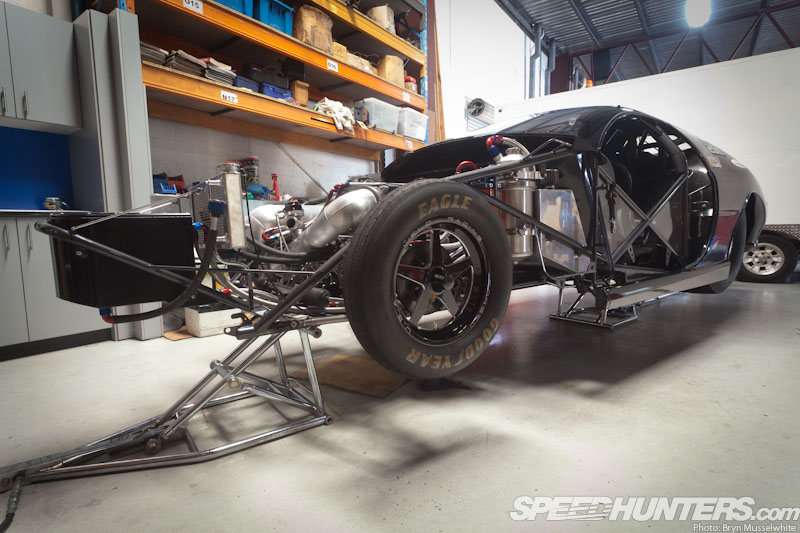
The incredible sensation I got in the pit of my stomach when I saw the 6 launch from inside the cockpit, it just pulled me in. I wanted to know how that felt, how you did it and who was doing it. The ‘why’ part had disappeared… That infectious celebration at the end? I wanted know who those guys were. Four weeks and 12,000 miles in cattle class later I saw the 6 in person, and the header photo was taken by me at the dragstrip I’d seen in the film. This is Speedhunting.
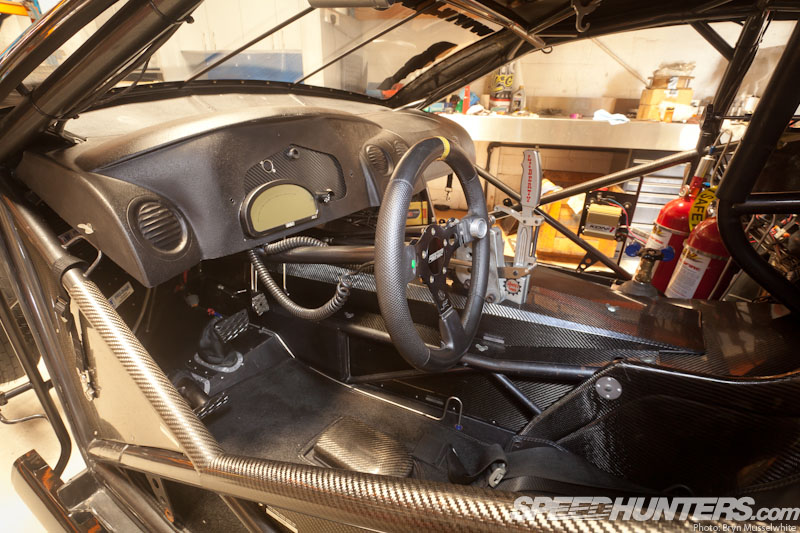
Realising that I’m now a drag racing fan, it makes me wonder why I’d never really previously connected with it as a sport. I’ve ridden in really quick drag cars, but never on a strip; I have friends who race down into the sevens, but I’ve never crewed for them – instead occasionally watching from the sidelines. Then I think again about the times I’ve driven the quarter mile and felt like ripping the back seats out for weight saving as I crossed the line, or got excited about commentating on a jet car run – and suddenly it’s clear: I’ve just been in massive denial.
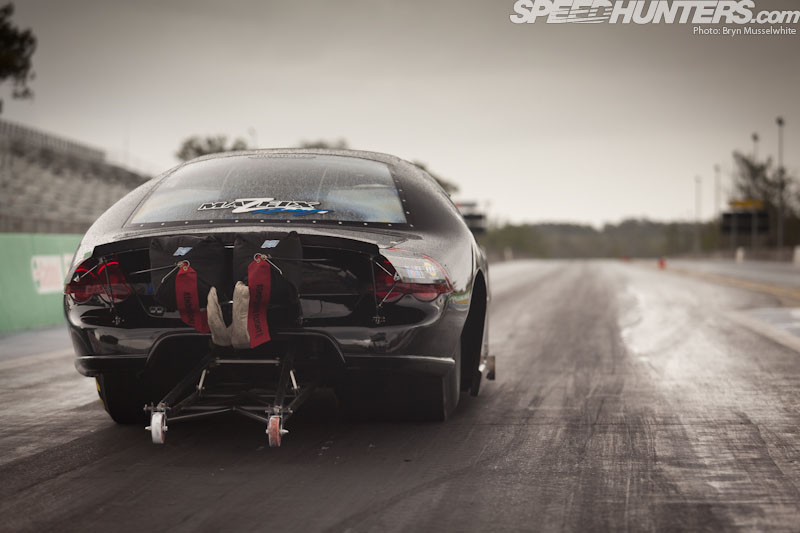
Archie Kajewski (pronounced kai-eski) was the first person in the world to go over 200mph on the dragstrip using a rotary; he was also the first in Australia to run a six-second quarter using one. He’s the man behind Mazfix, the Brisbane-based rotary tuner. Although he’s quick to point out it’s not just rotaries – but we’ll talk about that another time. As I stood at the strip, it was the definition of frustration as the rain started coming and racing was called for the day. The guys got one run earlier on in the morning and that was it… Game over. You see those speckles on the rear window? Their millions of friends arrived minutes later. Take another look at the rear profile of the body and you see just how it’s formed to flow air – not obvious from a cursory inspection.
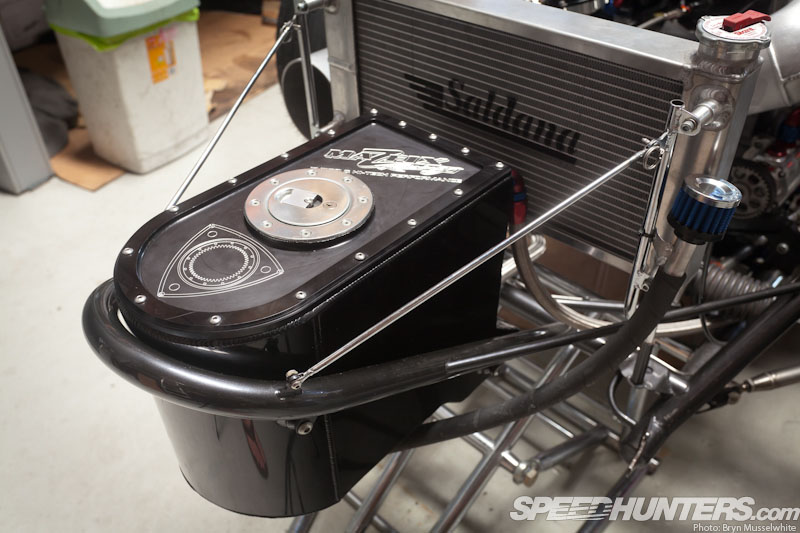
So what was I going to do? No racing meant everybody was going home, so I made a plan with Archie to visit the Mazfix HQ and get under the composite skin of this drag car. It’s odd, but I was really gripped with the need to know more, as though my sense of guilt at not having paid more attention before at countless strips had fully kicked in. The Mazfix Racing 6 was just the thing to satisfy my need for knowledge: gorgeous details abound, even though purpose is paramount.
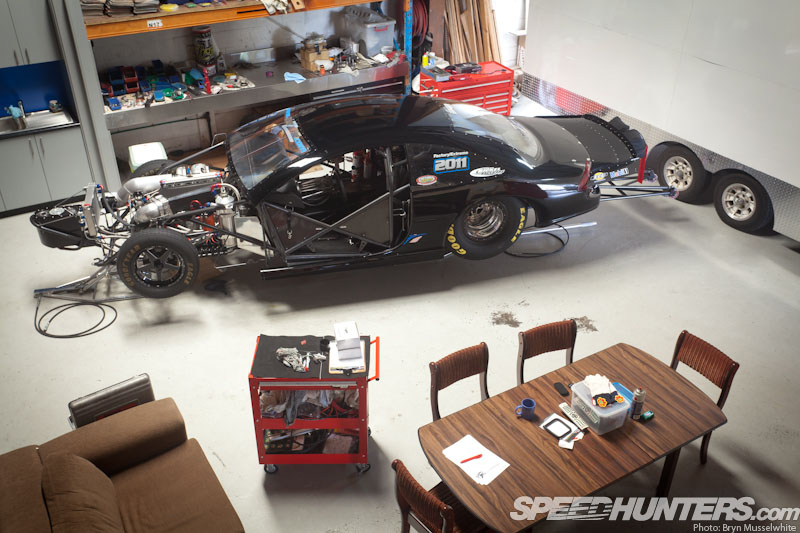
A few days later and I was in a spacious and busy workshop, and hidden in a back corner behind its large trailer was the 6. Partially stripped and raised on air jacks it sat like a sedated panther, allowing me access to analyse and understand. That table is where the guys have their breaks, lunch and chew the fat on a daily basis. The other side of the car is the microwave and water taps, so the 6 really is part of the fabric here and constantly under discussion.
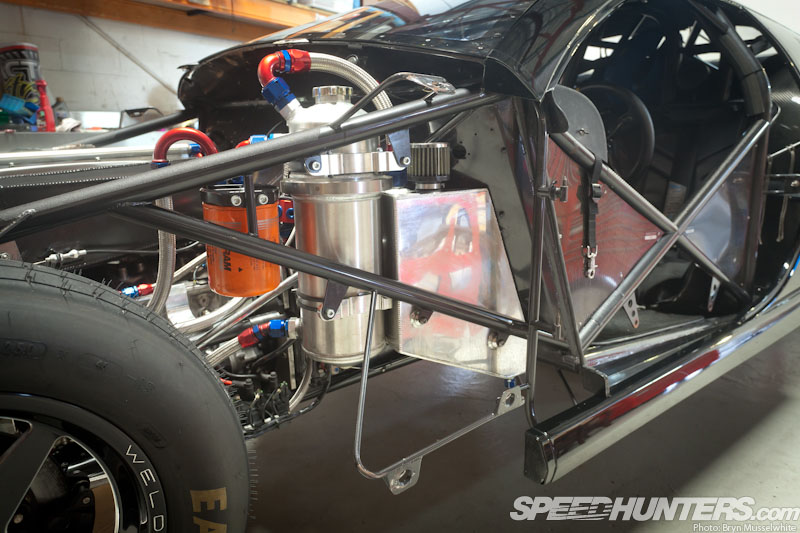
It’s here I could take a look around and try to understand just what it takes to go that quick. As I said, Archie is a seasoned drag racer with masses of experience and previous six-second runs – he’s been at it for years. So the first step was to start with a proven chassis and body package (albeit originally intended to have V8 power) bought in from the States, fabricated by Jerry Bickel Race Cars Inc.
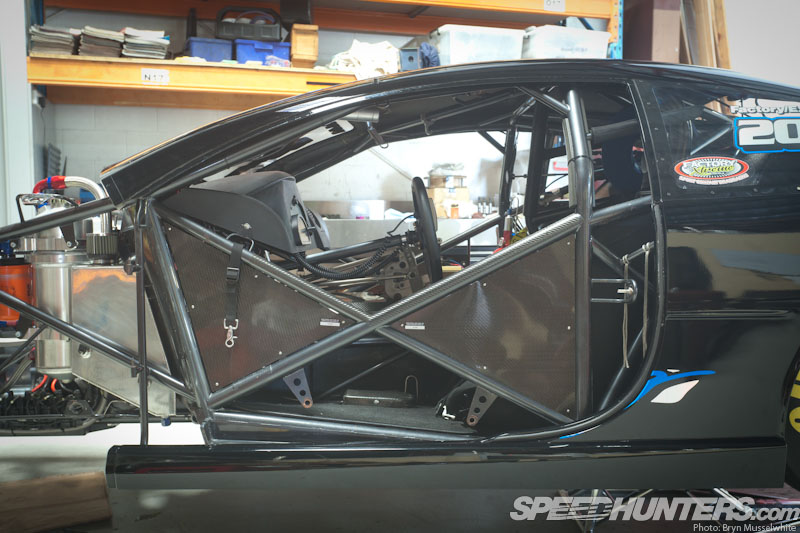
For a start this gives you an idea of safety measures in place: the carbon in-fill panels acting as a barrier if the door falls off. The tapered chassis is designed to distribute the force of an impact through the frame as that force moves rearward, whilst obviously allowing the body to be as slippery as possible. As I moved around the car Archie tells me everything is chromoly aside from the front suspension arms; they’re titanium, he tells me with a smile.
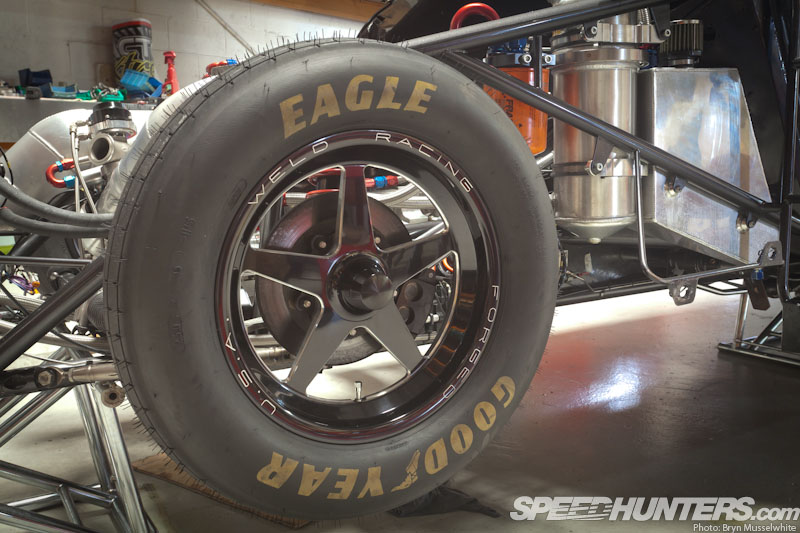
Wheels are obviously small at the front: they need to provide minimal steering and as little wind resistance as possible. You can see here how few runs they’ve done with the bobbles still present on the Goodyear Eagles. Spindle-mounted wheels are so simple in design, and I really like the machined details on these forged Weld items.
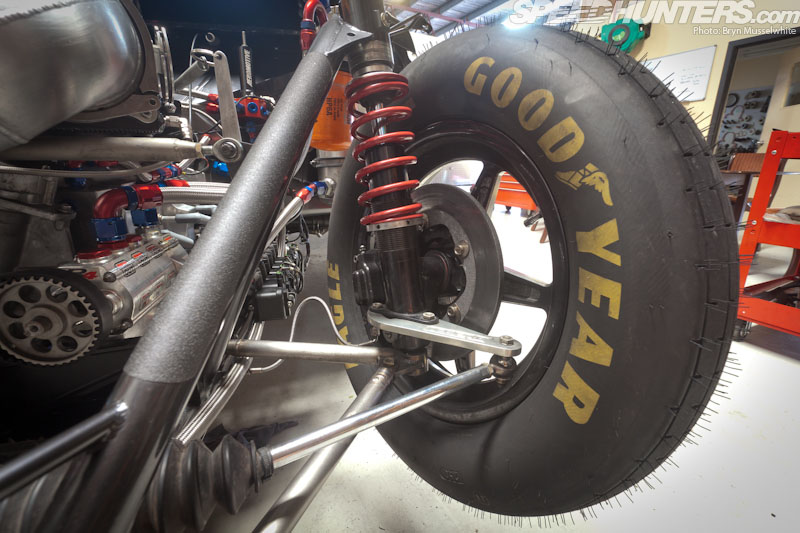
Behind them are Mark Williams floating carbon fibre discs, so these are able to move back and forth slightly with a simple, lightweight single-piston calliper. There’s no need for big brakes as the tyres wouldn’t be able to handle massive amounts of stopping power without locking up. Note the simple, familiar coilover set-up – another Jerry Bickel component. The spring rates remain a secret for Archie to keep though. I like the protective trim on the front chassis leg, helping to keep the paintwork chip free.
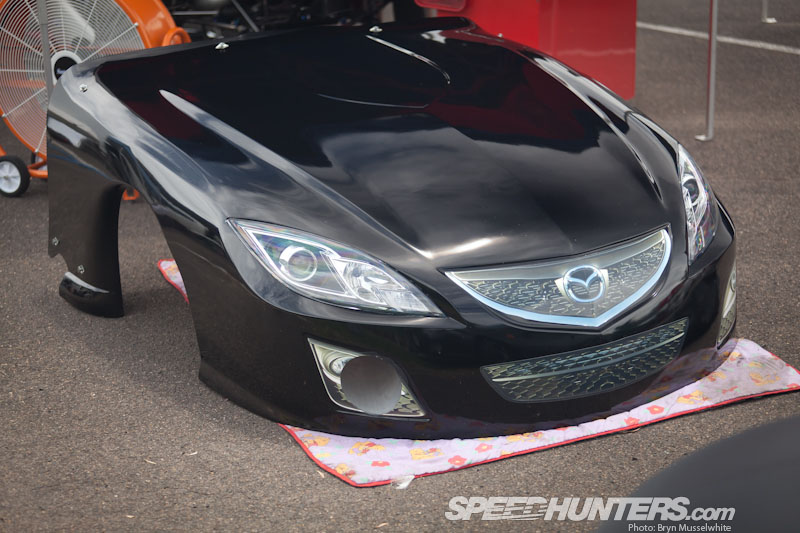
The front end that covers everything is obviously not a proportionally faithful copy of the Mazda 6, but with some cleverly applied graphics it does a pretty good impression. The headlights are real, and Archie tells me that they intend to get them working – although I’m fairly sure it’s not going to be for road legal reasons. Funny to think in decades gone by the lights and grille would have airbrushed on. Note here the turbo intake in the lower left-hand side.
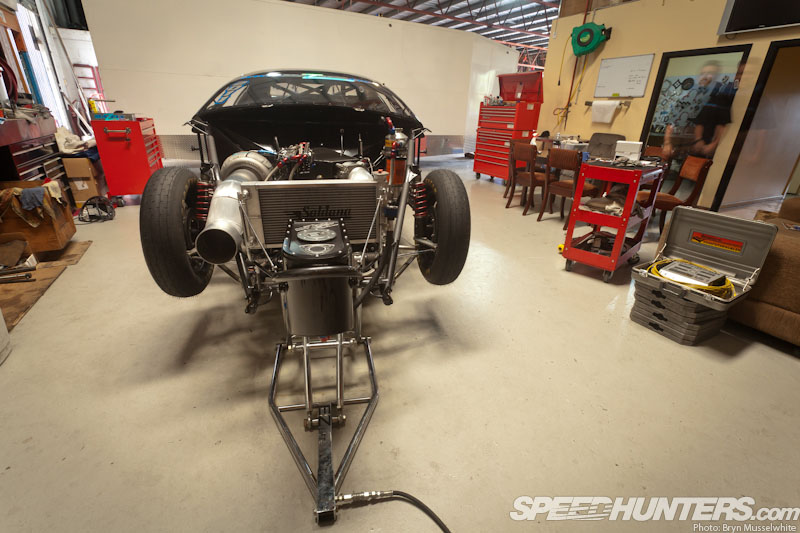
Here you can see the massive intake pipe which feeds the turbo on the Mazfix 20B Bridgeport. Obviously Archie isn’t about to give up all his trade secrets, but suffice to say this is the global pinnacle of rotary tuning. The motor fitted today is actually a prototype that employs aluminum plates, though the two quickest times so far have been done with a steel-plated motor fitted. I can’t wait to see just how much faster it goes when the guys get some seat time.
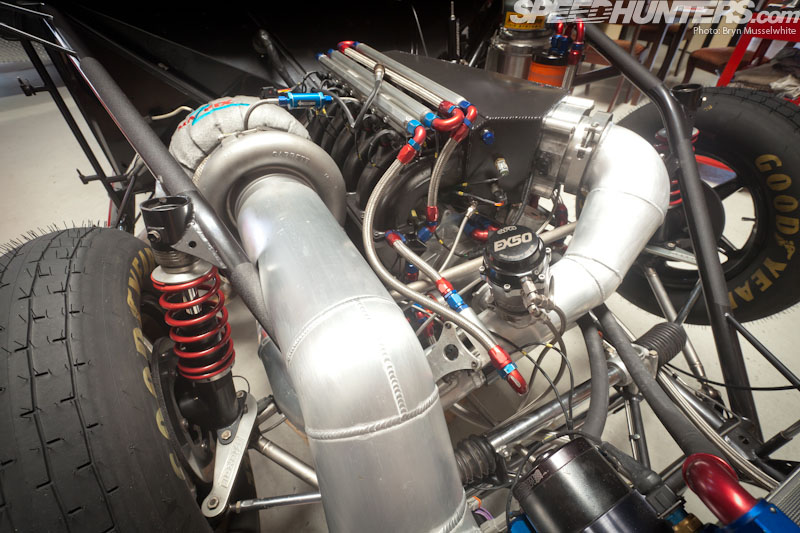
The real kicker for me here is that this chassis was designed to house a mountain V8 motor, but now the weight is much lower down and there’s no scoop on the bonnet, which intrigues me as to just how the team have made it all work. Archie says that it’s just down to testing, which they’d love to do more of. They’re a comparatively low-budget team though, and Archie reckons they’re getting there with the suspension set-up. Although as I experienced a couple of days previously, rain can stop play and days of valuable testing are missed. An interesting thing you might notice here is the lack of intercooler, Archie preferring to inject methanol straight in to the inlet pipe – a shorter tract helping feed the rotary no doubt.
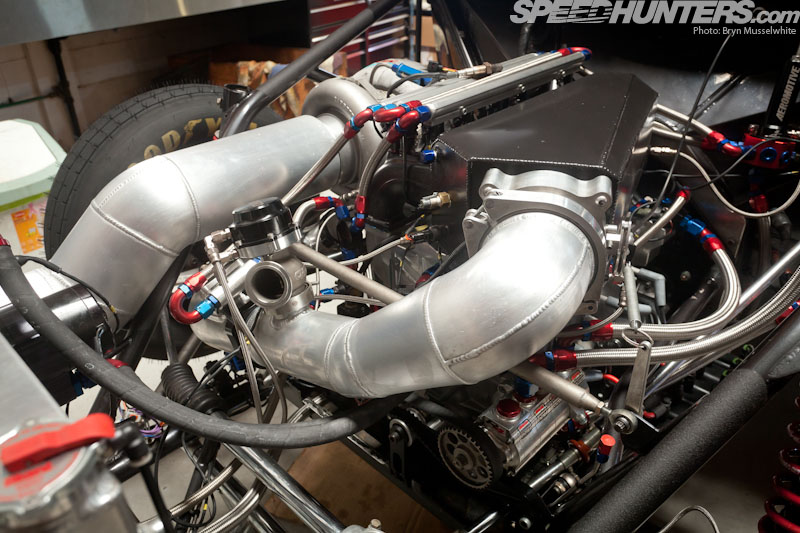
Although I’ve never owned a rotary-engined car, I’ve always admired the compact packaging they come with. Look at this picture and you can barely make out the ‘engine’ itself, it’s almost dwarfed by the intake and turbo. There are 15 2,000cc methanol injectors in total, with three per rotor and two in the inlet part way from the turbo. The engine was baselined on the Mazfix dyno but not taken to its limits, so Archie begrudgingly estimates that it’s putting out somewhere around 1,500-1,600bhp. I say that because he stresses to me that he’s not one of those guys who throws power figures around to show off, preferring to let the times doing the talking. There’s no nitrous here either, Archie favours boost, and he hasn’t even nearly run out of that yet.
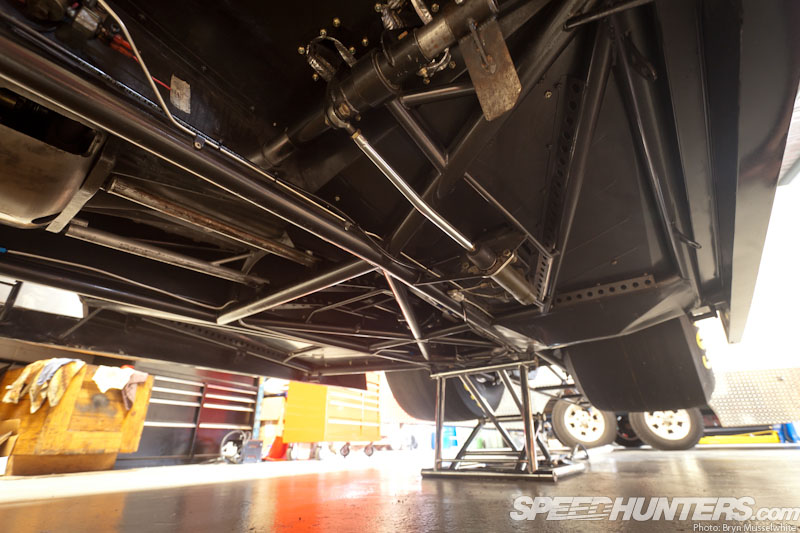
In fact Archie is a quiet guy and you can see he struggles a little with the attention that the 6 brings, but it’s that adrenalin hit that the throttle brings he can’t deny. So I was honoured that he let me crawl around the 6 today. Although there were certain things I know he has to keep secret he really just left me to get on with it, and I appreciated that. Normally the underfloor would be clad with a flat carbon undertray, but here you can see the simple chassis work – although that’s what it looks like to an untrained professional like myself, because this chassis is built to transmit the power to the back wheels just as much as any transmission.
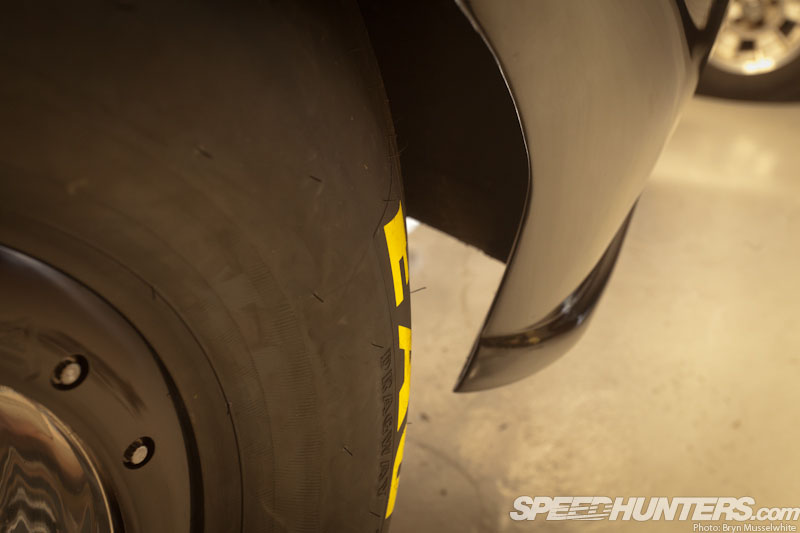
Moving around the back I notice how the bodywork tucks in behind the rear wheels, so at 200mph the rear arches don’t scoop up air like a bucket and try to rip free. Or worse, slow down the car…
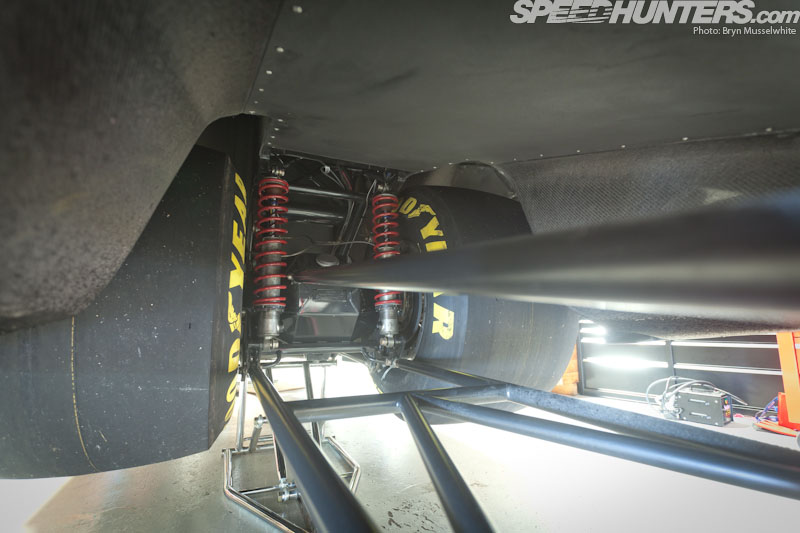
Under the rear end the magnitude of those Weld wheels and Goodyear tyres becomes clear. This is a view I’ve never seen before, so I sit and imagine the air flowing under the body then being pushed, pulled and formed over the smooth lines of the rear undertray. The wheelie bars are there to physically stop the car from flipping on the spot when those tyres get traction, effectively stopping the car from rotating around them.
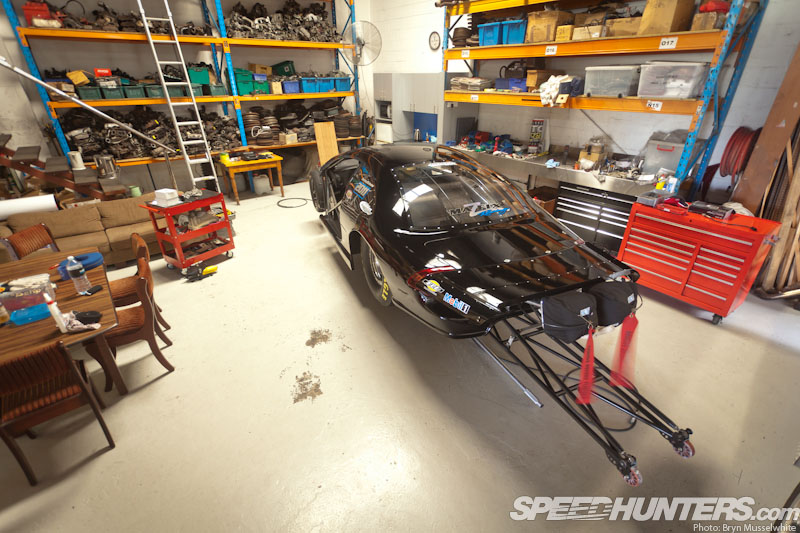
If they’re too stiff there’s no movement of intertia from front to back and that’s not good either: they need some weight transfer to get traction. This finely-balanced dance is the one Archie is perfecting at the moment, in the pursuit of the optimum launch.
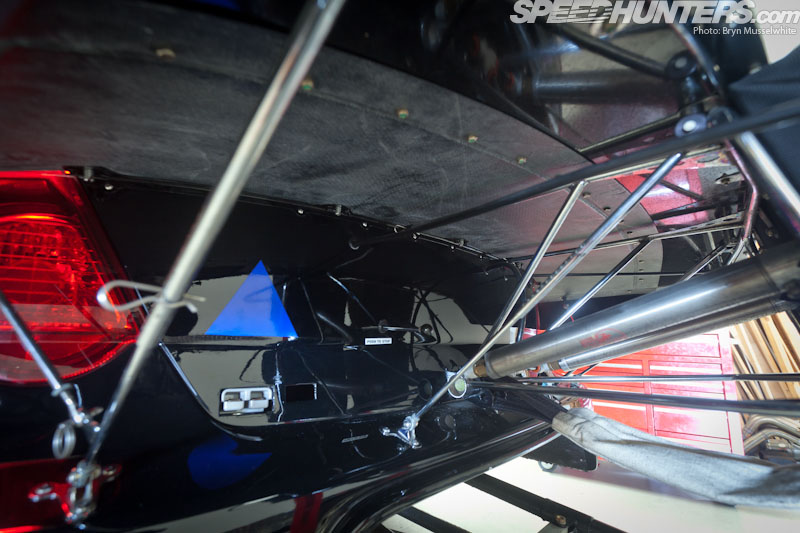
Of course air moves over the body too, with the rear spoiler further aiding traction and doing the job of clearing it from the rear of the Mazda cleanly and quickly.
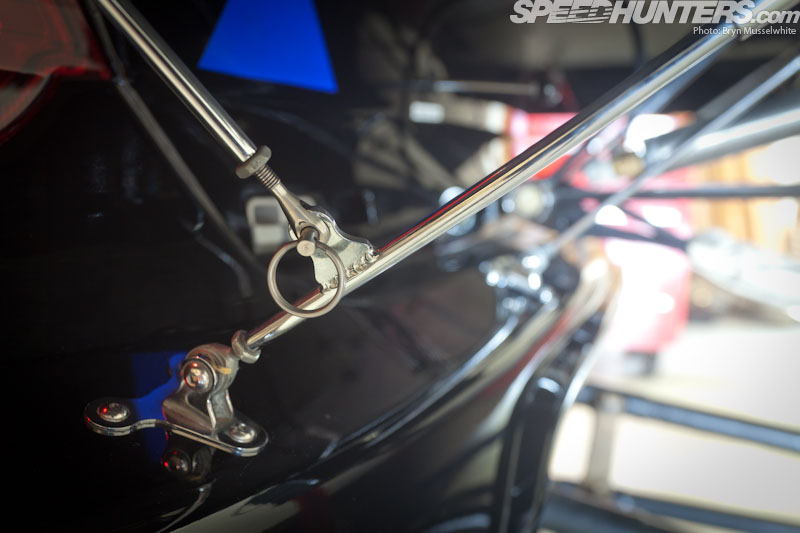
The forces involved must be massive; once again some exquisite engineering comes in to play with components like these rose-jointed mounts.
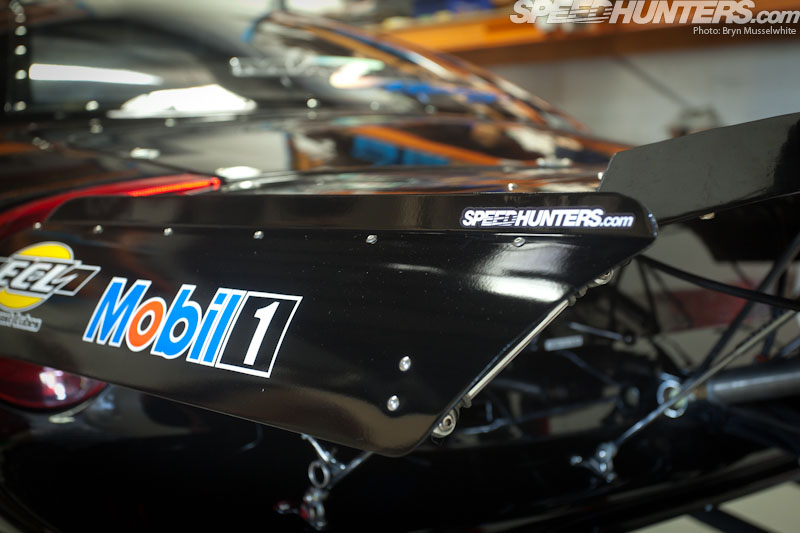
Aero is a science on its own and with the Mazda moving from static to 200mph in under seven seconds profile is important. The Speedhunters sticker is worth 10 percent increased flow across the rev range*.
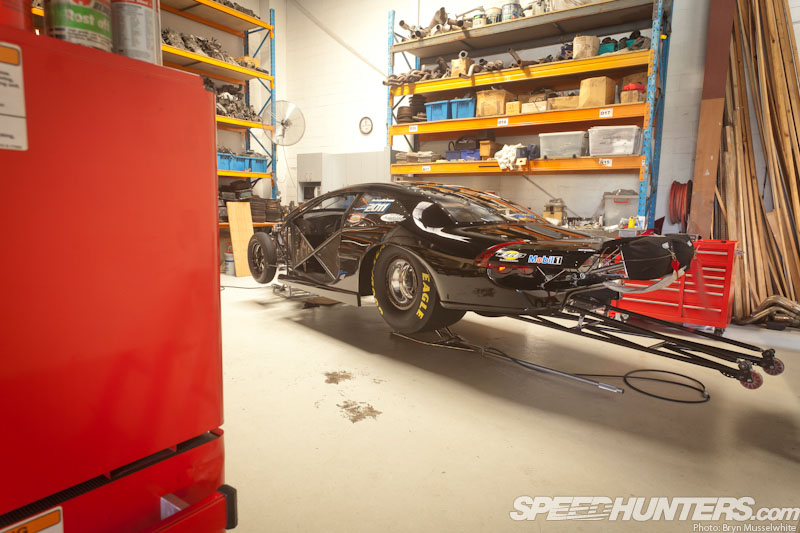
*This is a lie. This sticker should only be used as part of a professionally-controlled race package.

Going back to that film, I got a real sense of awe when I leant inside the cabin. The controls are intentionally simple; it still blows my mind that virtually the whole quarter mile is run with just one hand on the wheel. Only nearing the line after the final shift does Archie actually grip it with two hands.
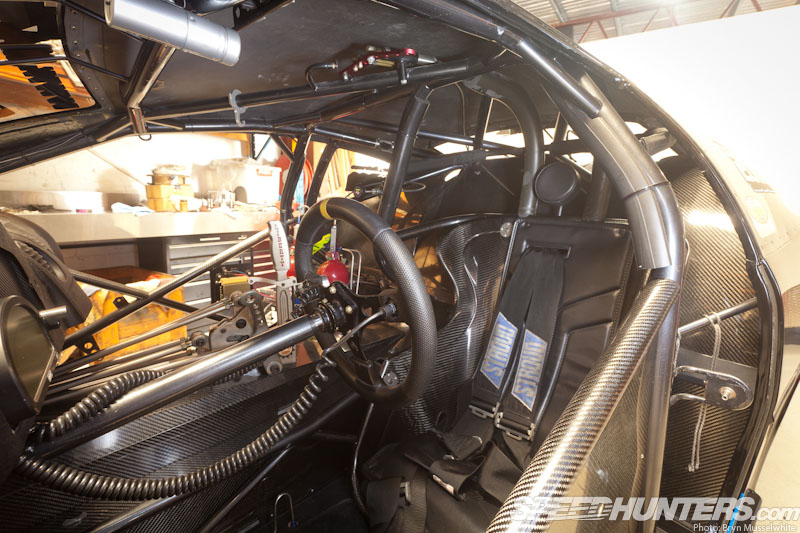
The safety cell is beautifully detailed to go with the function. Maybe it’s just the lack of graphics or colour, but it also looks like the kind of place the devil would ride when out harvesting souls…
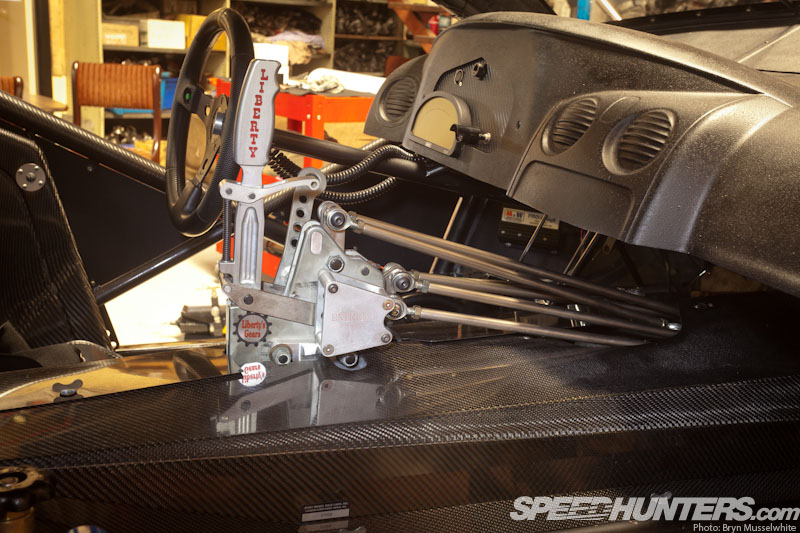
If it’s possible to pick the coolest part of the Mazda, for me this is it. A shifter that looks like the handle of duelling sword? A dagger that’s sole function is to slice time in to tiny slithers. And yes, incredibly it’s a manual. In my experience virtually all high-end drag cars are autos, so that the ‘box can be built to do the same thing every time the power comes knocking. Plus, if you’re running a six-second pass and having to shift gear four times during a run that’s a lot to think about.
So I when I question Archie, he tells me that it actually seems quite slow when he’s on a run, saying he waits for the revs to rise between each gear shift, for the lights on the dash to illuminate one by one until the shift light comes on and then bang… another cog. The brain’s capacity to deal with this situation is incredible, his expertise and experience counting for a lot too. Yes, he’s basically saying his brain slows time down – that and the fact it keeps things fun sticking with the manual…
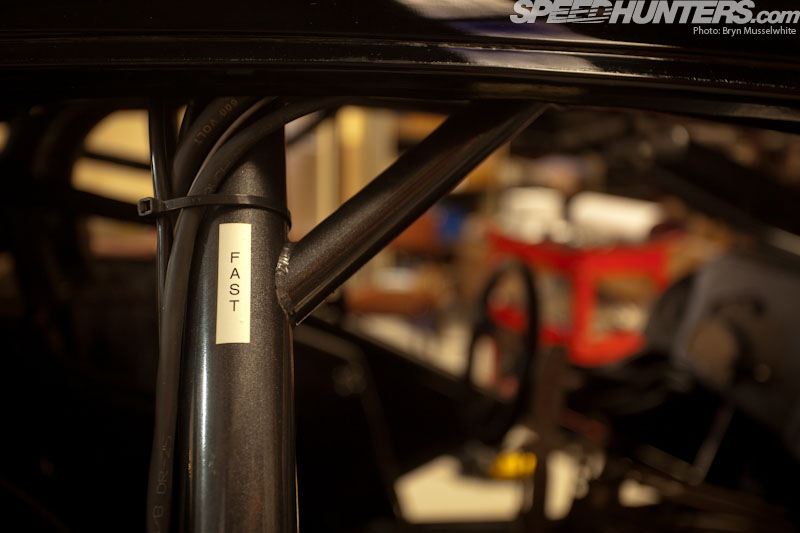
Or maybe this is the coolest part: quite possibly the only superfluous thing on the car. A simple sticker that I naively ask is significant. Maybe it denotes a type of fixing or point of contact that needs attention? No, it was made up and stuck on because you know what? The Mazda just is. In an otherwise very formal and purposeful build, this makes me smile and reminds me of the human element of this car.
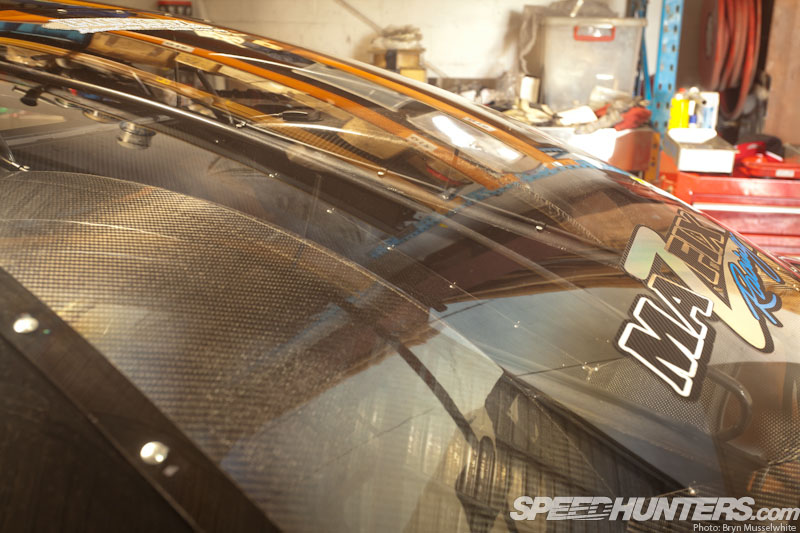
Of course there are also those massive carbon wheel tubs that almost touch the rear window too… Oh man, how can I choose? I hope now you’ve taken a look around the Mazfix 6 you can get a better idea of the purity of purpose involved with drag cars. Maybe that’s why it took so long for me to convert. I just lacked the dedication needed to experience what could well be the ultimate high in the automotive world. The intensity involved with everything about this car makes my skin prickle. Keep up to date with the Factory Xtreme series this year and see how Archie gets on…
I’ll apologise now if you’re a hardcore drag racing fan: I know this article may be lacking in technical detail, but the reasons for this are obvious and out of respect to Mazfix I wasn’t going to push any further, as Archie was more than accommodating when it came to my many questions.
Did you spot the tell-tale marks that the wheelie bars left on the start line? The guys spraypaint them before every run so they can gather as much data as possible.
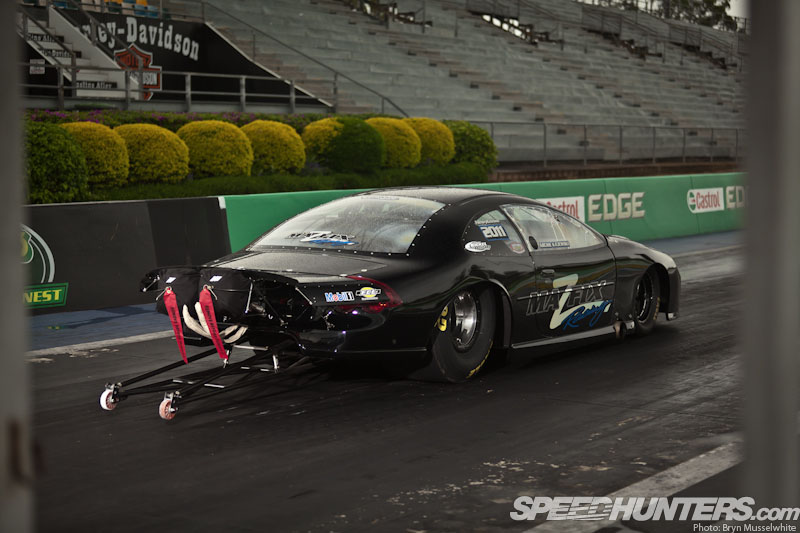
Right now I’m sat back at the computer where I first saw the film back in January. I’ve travelled to Australia and back, met some good, good people and seen some amazing cars. There’s more to come yet, but I genuinely love the sensation I get when I think about that, the smile it puts on my face when I look at this picture and know I took it. So if you leave this page understanding a bit more about how you can get from standstill to 200mph as quick as this car does and somewhere inside you wonder what it would feel like, then I’m glad – because I genuinely have no idea how I’m ever going to manage it… but I’d sure like to try.
Bryn Musselwhite
Chassis and body
Jerry Bickel Race Car Inc built chromoly, titanium suspension arms, carbon fibre bodyshell with Mazfix modified front half to ape Mazda 6 lines, carbon interior panels with carbon wheel tubs, twin parachutes
Engine
Mazfix Bridgeport 20B with alumium plates, Mobil 1 15/50 oil, dry sump system, Motec M800 management system
Wheels and tyres
Weld Racing forged rims, Goodyear Eagle tyre
Transmission
Liberty five speed manual, Jerry Bickel nine-inch back axle with 40 spline shafts
Brakes
Mark Williams carbon discs and aluminium calipers
Suspension
Jerry Bickel front and rear struts
Interior
Coldfire safety system, carbon seat, Jerry Bickel fabricated interior panels
Thanks
Mobil Oil, East Coast Lubes, BP Race Fuel, GFB – Go Fast Bits and all my team…
Contact Mazfix for some of their unique expertise here

Photo by Bryn Musselwhite

Photo by Bryn Musselwhite

Photo by Bryn Musselwhite

Photo by Bryn Musselwhite

Photo by Bryn Musselwhite

Photo by Bryn Musselwhite








Rotary motor:
12,428 hp
17 lb. ft
Thank you for giving us numbers which are meaningful only to people who don't understand horsepower, or torque, or the relationship between them. I also notice that you casually left out the RPM
Rotaries are in all cases very high RPM applications, which means that their low torque is ALWAYS (100% of the time without any exceptions in any circumstances) offset by their high operating speed. Guess what sort of motorsport suits engines whose peak operating window is at the very top of the rev range? You guessed it, drag racing.
Why do you think Formula 1 cars operate around 20,000 RPM? It's not for laughs. Little Japanese sports bikes operate on the same principle. Imagine a tiny bike with 200lb-ft at 4k rpm, instead of 200bhp at 9 million rpm? It'd just lose grip or turn you over every time you tried to accelerate
I suggest you read this: http://www.hotrod.com/techarticles/hrdp_0401_torque_horsepower_guide/viewall.html
The relationship between torque and horsepower is wildly more complex than I imagine you think it is
@ComJive Dr Sir, Reference your communication of 14minutes ago, thank you, that was greatly appreciated. Regards, Bryn
@ComJive It was a joke, child. That's all. A mere joke. Calm your jimmies.
still got owned...
MrChrisDiggs damn.
LSallthethings yeah.
@ComJive And the award for over reaction of the century goes to:
*drum rolls*
COMJIVE!
@ComJive And the award for over reaction of the century goes to:
*drum rolls*
COMJIVE!
@ComJive How did he get owned? He made a joke, some guy totally over reacted and then gave a pretty half assed technical explanation of engineering with a link to hot rod magazine. How is that getting owned.
I swear to God...it's like they let anyone post things on the internet these days. Wait...
can't get too technical on this site, idiots think you're trying to be the next andrew brilliant even if you actually know about whatever it is that you're discussing.
of course people still complain even if you keep it simple, as you have demonstrated
i'd say it goes to you, for talking about what i said not once, but twice
Growing up my father and I built a drag car together, it was a Mopar (or no car) and I thought it was pretty fast. Managed to run mid-10's on a 10.5-inch slick, I can't even imagine how hair-raising sub 7 second runs are. Drag racing was my first foray into motorsports, I still miss it but I totally understand how someone, even as a regular spectator, can't seem to find a natural love for the spectator. I still feel lackluster about the sport at times, but memories of pushing the car on the trailer or pulling up to the time-slip booth remind me of how much fun it was.
That's a beautiful car, no matter how you slice it. Achieving 1600bhp from 2-liters of displacement is an amazing achievement, regardless of whether or not it makes only 17 torques.
Beautiful car, nice article. Thank you.
*sport, meant to say sport, not spectator, "natural love for the sport*"
@ComJive Very informative Article @ HotRod!
Now i can appreciate this machine even more, the fact that it has such low torque (im assuming) relative to its quad digit HP yet it runs 6sec quarters!!! BUahahahaaa!!!!!
@ComJive Is that why top fuel cars run V8s instead of rotaries? Thats weird huh?
You already won the prize man. I couldn't possibly take it from you, that would just be cruel.
Top fuel runs at 8000hp region, the engine basically needs a rebuild after every run, the pushrod type V8 makes this more time and cost effective compare to twin or single OHC type engine, which is why they still maintain this layout, so basically rotaries, if they're needed to produce this kinda hp (if possible) the time and cost for a rebuild after every run, which it will have to, will be at the disadvantageous side compare to piston engine. Hope this clears it for you ??
I know what they run, I was trained by a guy who built top fuel engines for 15 years. Pivotal phrase "if possible" meaning they have never done it. Meaning the most powerful engines in the world (per liter or however you want to dissect it) are running V8s.
Ouch.
I was being sarcastic to put ComJive in his place.
ok calm down, just saying, technical fact talks, and internet bullshit walks.
its not entirely true if you want to go by the hp to liter ratio, a 2 liter making 1600 hp would translate to a 7 liter v8 needing to make...around 5800hp and theyre running nitro methane and either superchargers, turbos and natrious....so add nitrous to that rotary and lets see a car catch it. shall we.
How comes they don't just fair-in the rear wheel wells?
I know the idea is to not crash, but unpredictable as they are, I wouldn't put a petrol tank right at the front of the car. They are designed to flex and not allow piercing, they aren't crumple zones. This is the second drag car in a week I've seen like this, thats two less drag cars I would like a ride in.
http://www.youtube.com/watch?v=7mS2dZV5jw4
http://www.youtube.com/watch?v=7mS2dZV5jw4
man i need to get myself to a drag racing event pronto!!!
man i need to get myself to a drag racing event pronto!!!
man i need to get myself to a drag racing event pronto!!!
man i need to get myself to a drag racing event pronto!!!
Are those Dodge Stratus Coupe tail lights on the body shell? I guess the Mazda visual similarities stop with the front end. Makes sense, given that the shell was fabricated in the US.